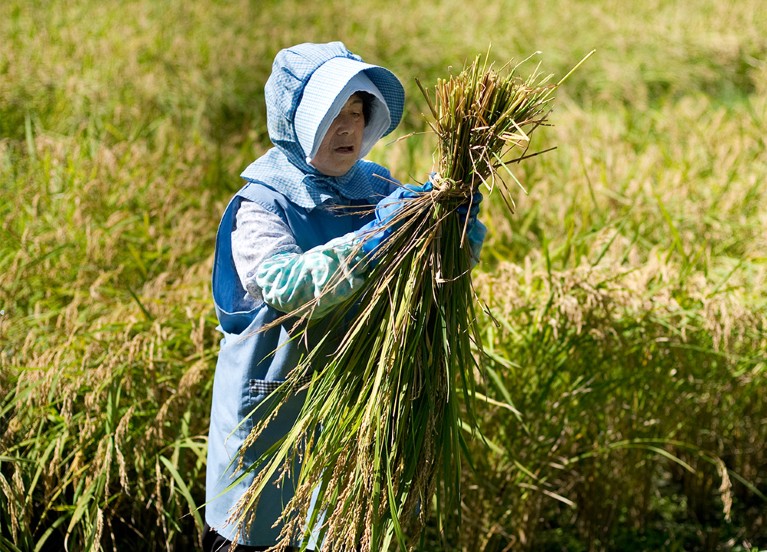Tags
Creating a future for rice cultivation
High tech and age-old agricultural traditions are being used to reverse the decline in one of Japan’s top rice-growing regions.

More than four centuries of agricultural tradition are at risk of coming to an end in Niigata prefecture in Japan.
The region is the famed origin of koshihikari rice — one of the most prized varieties in the world due to its sticky texture and sweet flavour. But the skilled rice farmers who tend the land are ageing and not being replaced by young people in the prefecture, who often choose to live and work in one of Japan’s bustling cities such as Tokyo or Osaka.
“Almost 60 households in this community used to be farmers: now there are only six,” says Fumikazu Nakamura, a 53-year-old farmer who lives near Nagaoka, Niigata’s second largest city.
This drain is threatening the land itself. As the farms are terraced and water flows from the mountains through them, one farm closing can have knock-on effects on farms lower down, explains Wataru Ogasawara, a bioengineering professor at Nagaoka University of Technology.

This creates a burden on those who remain. “If this situation continues, there will only be one or two farms left here in 10 years,” says Nakamura. “We feel a sense of crisis.”
“If there are no more farmers, the land will be more and more degraded,” agrees Shigeyuki Osabe, a 36-year-old farmer, whose family farm cultivates rice and also serves as a place for food education for children and tourists.
Combined with a shrinking and ageing agricultural workforce, this creates a vicious cycle that affects the markets of other rice-related industries such as rice confectionery and sake brewing, which in turn accelerates the outflow of human resources from Niigata.
This is where Ogasawara comes in. The son of a farmer from Iwate prefecture, he and his brother both left to pursue careers elsewhere — his brother as a medical doctor, and Ogasawara as a researcher specializing in microorganisms. “We couldn’t keep the farm going, and I felt a little guilty,” he recalls.
When he came to Nagaoka, he realized a similar situation was happening there and was determined to find a scientific solution to help reinvigorate farming as a career in the region.
Biocommunities
In 2021, Nagaoka was recognized as one of six so-called ‘biocommunity towns’ as part of a wider government initiative called the Japan Bioeconomy Strategy. It brings together 59 organizations including academic institutions, industry and government, with the goal of transforming Nagaoka into a sustainable, circular and bio-based economy.

Building on this is the 10-year KOME-DOKORO (or ‘rice producing region’) COI-NEXT project funded by the Japan Science and Technology Agency which began in 2022 and is led by Ogasawara and Nagaoka University of Technology. “It will bring together technologies from various fields at the university to address serious regional issues,” says Shigeharu Kamado, the president of Nagaoka University of Technology
The project is focused on addressing the critical situation in Niigata’s rice fields. It brings together farming, industry, government and academia stakeholders with the aim of making agriculture profitable and attractive to young people as well as enabling co-creation across industries and establishing new industries.

The COI-NEXT project has two main targets: establishing sustainable rice production and creating high-value products from unused resources such as waste from rice processing.
The first target focuses on ways to make rice farming more sustainable. “We have a lot of rice fields in streams and mountains,” says Osamu Ikeda, a 44-year-old farmer in Nagaoka. “The problem is that the work in these areas is inefficient and yields are low.”
Specific projects to address this include developing robots to perform difficult manual tasks such as weeding; creating designer compost enriched with beneficial microbes to maximize crop yield; and using multiomics and machine learning to identify insights that will help make rice cultivation more sustainable.
The second target takes a different approach by looking how microbial fermentation (hakko in Japanese) can transform unused resources and by-products of rice production into high-value-added products such as aquaculture feed, detergents, and functional foods.
Looking ahead
By bringing farmers, researchers, government and industry together, the COI-NEXT project is set to transform rice farming in Nagaoka so it is both profitable and attractive to young people, while preserving centuries of tradition.
“We will co-create future rice fields with farmers and other industries to foster a biocommunity, while fully circulating regional bioresources,” explains Ogasawara. “We hope this project inspires citizens to see rice fields as their own.”
Nagaoka farmers are on board with this. “Now is the time for us to create a future where those who wish to try agriculture are set up well to face the challenge,” says Osabe.
https://www.nature.com/articles/d42473-024-00150-yPublished Date: September 14, 2024






